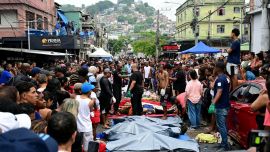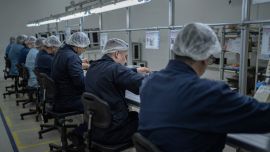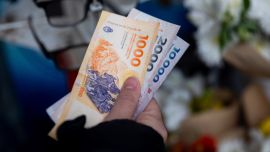When Mauricio Macri won the presidential election, he said his primary goal would be to eliminate poverty and that he should be judged by how far his government had advanced toward accomplishing that aim.
Taking office without trustworthy data from the INDEC national statistics bureau, the first year wasn’t plain sailing. Confronted with official data in the first half of 2016 that indicated that 32.2 percent of the population were below the poverty line, experts at the Catholic University of Argentina (UCA) warned the true figure was even higher. However, progress was made. INDEC’s figure fell to 30.3 percent (an estimated 12.7 million people) by the latter half of 2016. The following year, things continued to improve. Inflation decreased, GDP grew, and poverty fell to 25.7 percent in the second half of 2017, according to INDEC.
Today, the panorama changed. In April, an unexpected run on peso prompted economic concern, coupled with a significant loss in purchasing power thanks to rising inflation. Although the full effects of devaluation haven’t hit yet, recent inflation data indicates that the aftershocks are only just arriving – and experts warn they will hit the poorest hardest.
Take the price of the basic basket of household foodstuffs, a tool used to measure inflation and purchasing power. Costs increased by 4.9 percent in June, following on from 4.8 percent in May, higher than inflation estimates over the same period. In June alone, flour increased by 25.8 percent, bread by 10.8 percent, cooking oil by 11.8 percent, noodles by 7.6 percent and ground meat by 8.4 percent.
Thanks to these price increases, a family now needs to earn 19,601 pesos per month not to be considered as falling below the poverty line. And they need to make 7,830 pesos just to be able to afford the necessary foodstuffs for a household. That represents an 18-percent increase when compared to the beginning of the year (inflation in the first six months totalled 16 percent, INDEC reports).
While householder earners that have formal or professional jobs are partially compensated by salary adjustment agreements unions negotiate with employers, those who work in the informal sector (the majority of the poor) are suffering the most. They do not receive wage hikes or salary adjustments.
SOUP KITCHENS
“It’s evident that there is more demand now, in the past few months we’ve seen more people coming to our soup kitchen.”
Rubén Benítez runs the San Miguel Arcangel Community Dining Room in the Buenos Aires City neighbourhood of Villa Soldati. Speaking with the Times in an interview, he said more people are coming to his establishment every day.
“Everything is more expensive, and there isn’t any work. I have 90 spots, but more people are coming then we can fit in,” he said.
Benítez’s soup kitchen isn’t the only place that’s experiencing a surge in people looking for help.
Manos Solidarias, a local foodbank that works in Buenos Aires province, delivers donated fruit and vegetables to members of the community. Registered as a NGO, it is a member of a wider network in Argentina that delivers nutrition to those in need, the Red Argentina de Bancos de Alimentos.
A recent report from Noticias Argentinas said the organisation's depositary in the beachfront city of Mar Del Plata has witnessed a 30-percent increase in requests for food assistance in June. An estimated 8,000 people today depend on the organisation for help, its organisers say.
“We want to pass a nutritional emergency law because we are in a precarious situation,” the Bishop of Mar del Plata Gabriel Mestre said after a recent visit to site.
Hunger is crucial in the fight against poverty and a major challenge. It can hit children the hardest. The latest report published by UCA’s influential unit, the Observatory of Argentine Social Debt (ODSA), revealed that 48.1 percent of children in Argentine live in poverty, with 33.8 percent having breakfast, lunch, and snacks in soup kitchens or school community kitchen.
Dig deeper and the numbers are even more alarming: the number of children seeking assistance increased by at least eight percent over the last year, according to ODSA (whose study was based on a survey of 5,700 metropolitan areas throughout the country).
PRICES v RISES
“The problem is that prices are continuing to go up while the increases to social assistance programmes or pensions aren’t keeping up. Consumption is falling the most with those who have less, leading to a rise in people going to soup kitchens,” Agustín Salvia, the director of the Observatory of Argentine Social Debt, told the Times in an interview.
For a household dependant on social assistance programmes to make ends meet, it isn’t easy. In order not to be considered to be living in extreme poverty, a family has to be earning more than 8,000 pesos per month at present. Many poor families say social assistance programmes aren’t enough for the families whose parents can’t find work and have no other source of income.
At the same time, experts warn there is less employment for work known as “changas,” odd-jobs such as cleaning, gardening, repairs to machinery or carpentry, which many people in low-income areas rely on. Although these jobs don’t provide a steady flow of income, as they aren’t stable, they are crucial in providing the extra money to keep their families afloat.
In the first quarter of 2018, unemployment increased to 9.1 percent, according to INDEC. In addition, 15.1% percent of the population is employed but are seeking more work or better opportunities because they are “underemployed.” In total, an estimated three million people in Argentina suffer from being unemployed or under-employed.
Salvia, the ODSA director, complained that the government doesn’t have much of strategy to deal with the poverty problem. Instead, he said, they are focused on trying to stabilise the current financial crisis.
“Regarding poverty, the second half of the year will continue to get worse until the end of the year, then there is a possibility sibility that the scenario could improve as inflation decreases, and economic activity starts to recuperate,” he explained.
Others, however, are more pessimistic, predicting that poverty will continue to worsen well into 2019. With the government following the adjustment programme agreed with the International Monetary Fund (IMF), some economists argue that the Macri administration will have to aggressively cut social welfare programmes and public works projects that employ citizens in order to meet their fiscal goals.
“The adjustment programme that the government has agreed to with the IMF will not be a solution for poverty, and will worsen the situation for those sectors that need subsidies,” said Andres Asiain, the director of the CESO (Scalabrini Ortiz Centre for Social and Economic Studies).
According to the INDEC, in the second half of 2017 an estimated seven million people were in poverty, with 1.3 million people suffering from extreme poverty. There seems to a consensus amongst experts that those numbers will increase before they start to fall again.
“The combination of the inflationary effect with the government following the IMF’s adjustment program, will generate more poverty,” argued Asiain.
While experts are concerned, the current crisis does not compare to the economic meltdown that hit Argentina in 2001-2002, when almost half the population was plunged under the poverty line, and nearly a third lived in extreme poverty.
“This crisis is similar to the levels of poverty we had in 2014 or 2016. It’s not an explosive situation. They have levels of social welfare protection. But a large percentage of the population doesn’t have access to an income that permits them to live with dignity,” said Salvia.


























Comments